A Broadwell Retrospective Review in 2020: Is eDRAM Still Worth It?
by Dr. Ian Cutress on November 2, 2020 11:00 AM ESTGaming Tests: Civilization 6
Originally penned by Sid Meier and his team, the Civilization series of turn-based strategy games are a cult classic, and many an excuse for an all-nighter trying to get Gandhi to declare war on you due to an integer underflow. Truth be told I never actually played the first version, but I have played every edition from the second to the sixth, including the fourth as voiced by the late Leonard Nimoy, and it a game that is easy to pick up, but hard to master.
Benchmarking Civilization has always been somewhat of an oxymoron – for a turn based strategy game, the frame rate is not necessarily the important thing here and even in the right mood, something as low as 5 frames per second can be enough. With Civilization 6 however, Firaxis went hardcore on visual fidelity, trying to pull you into the game. As a result, Civilization can taxing on graphics and CPUs as we crank up the details, especially in DirectX 12.
For this benchmark, we are using the following settings:
- 480p Low, 1440p Low, 4K Low, 1080p Max
For automation, Firaxis supports the in-game automated benchmark from the command line, and output a results file with frame times. We do as many runs within 10 minutes per resolution/setting combination, and then take averages and percentiles.
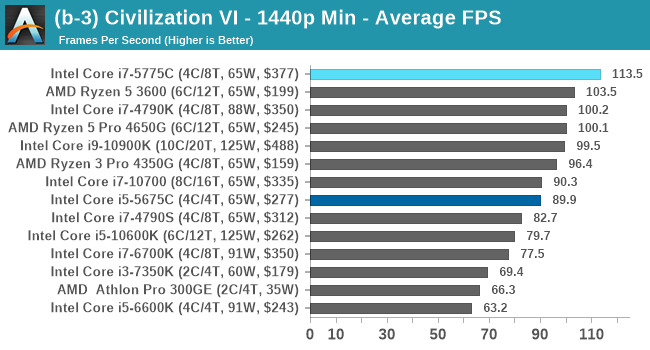
| AnandTech | Low Res Low Qual |
Medium Res Low Qual |
High Res Low Qual |
Medium Res Max Qual |
| Average FPS |  |
 |
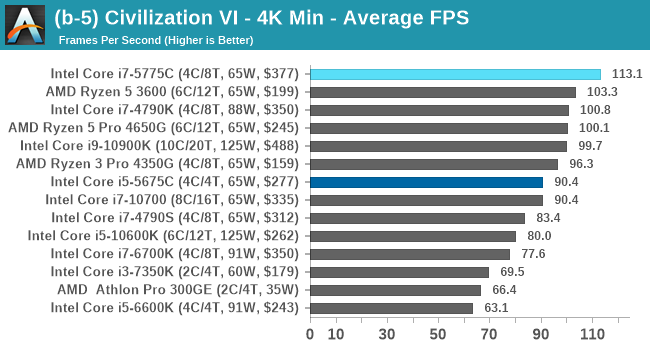 |
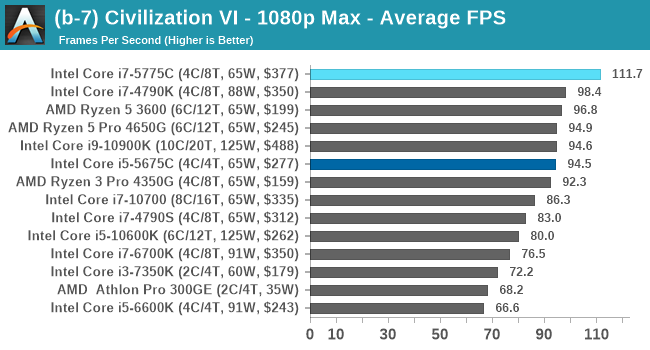 |
| 95th Percentile | 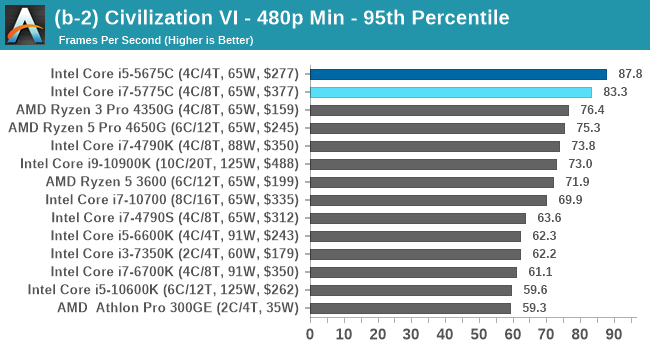 |
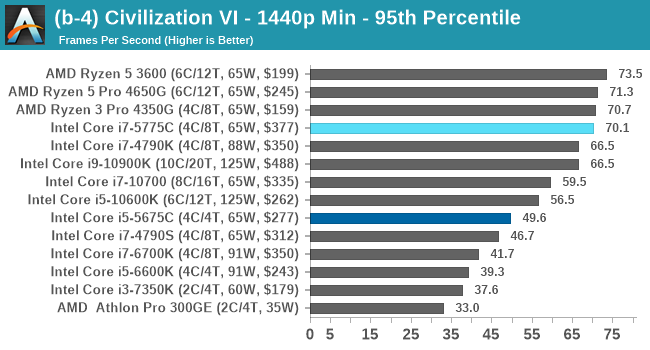 |
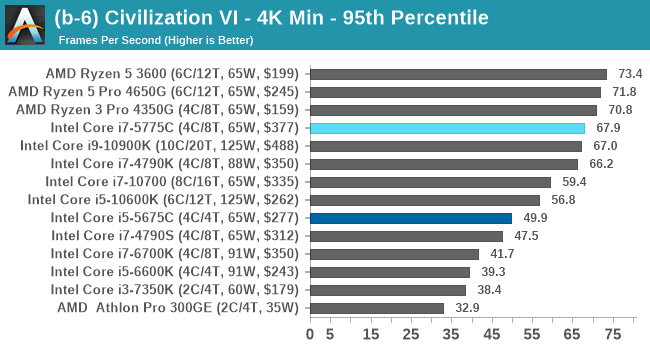 |
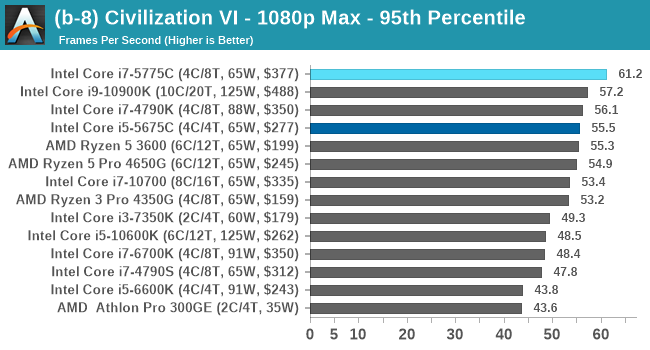 |
Civ 6 has always been a fan of fast CPU cores and low latency, so perhaps it isn't much of a surprise to see the Core i7 here beat out the latest processors. The Core i7 seems to generate a commanding lead, whereas those behind it seem to fall into a category around 94-96 FPS at 1080p Max settings.
For our Integrated Tests, we run the first and last combination of settings.
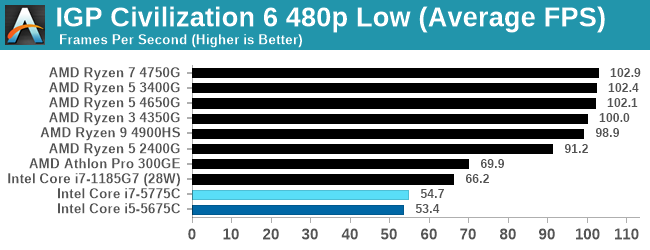

When we use the integrated graphics, Broadwell isn't particularly playable here.
All of our benchmark results can also be found in our benchmark engine, Bench.











120 Comments
View All Comments
Khenglish - Monday, November 2, 2020 - link
The infinity cache is SRAM, which will be faster but much lower density. Only IBM ever integrated DRAM on the same die as a processor. The DRAM capacitor takes up the space where you want to put all your CPU wiring.Quantumz0d - Monday, November 2, 2020 - link
Always thought why Intel is so fucking foolish in making that shitty iGPU die instead of making eDRAM on the chip. It would have given a massive boost for all their CPUs. A big missed opportunity. AMD had this "Game cache" on their Zen 2 and now with RDNA2, "Infinity Cache" again..jospoortvliet - Wednesday, November 4, 2020 - link
I guess they did the math on cost and power. They always had better memory controllers and prefetchers so they didn't benefit as much from cache- they also have the memory controller on-die, unlike amd with their i/o die. So intel would benefit waaaay less than amd does, in almost every way.dragosmp - Monday, November 2, 2020 - link
"...the same 22nm eDRAM chip is still in use today with Apple's 2020 base Macbook Pro 13"Ahem, what? Is that CPU an off the roadmap Tiger Lake?
Jorgp2 - Monday, November 2, 2020 - link
Tiger Lake doesn't have the hardware for an L4.It's probably the Skylake version
colinisation - Monday, November 2, 2020 - link
Do the part numbers on Intel CPU's mean anything, I picked up a 5775C a week agoand have not installed it yet but the part number starts "L523" - I just assume it is a later batch than what is in the review.ilt24 - Tuesday, November 3, 2020 - link
@colinisationThat L523 are the first 4 characters of the is the Finished Process Order or Batch#.
The L says it was packaged in Malaysia
The 5 says it was packaged in 2015
The 23 says it was packaged on the 23rd week
Digits 5-8 are the specific lot number number of the wafer the die came from
colinisation - Tuesday, November 3, 2020 - link
@ilt24 - Thank you very muchMday - Monday, November 2, 2020 - link
I expected more eDRAM implementations after Broadwell coming from Intel and AMD on the CPU side, as a low latency - high "capacity" cache, particularly after the launch of HBM. It made me wonder why Intel even bothered, or what shifts in strategies moved them to and away from eDRAM.ichaya - Monday, November 2, 2020 - link
This is really the first desktop part I'm hearing of, weren't most of these "Iris Pro" chips sold in Apple laptops with maybe a small minority being sold by other laptop OEMs? I believe so.